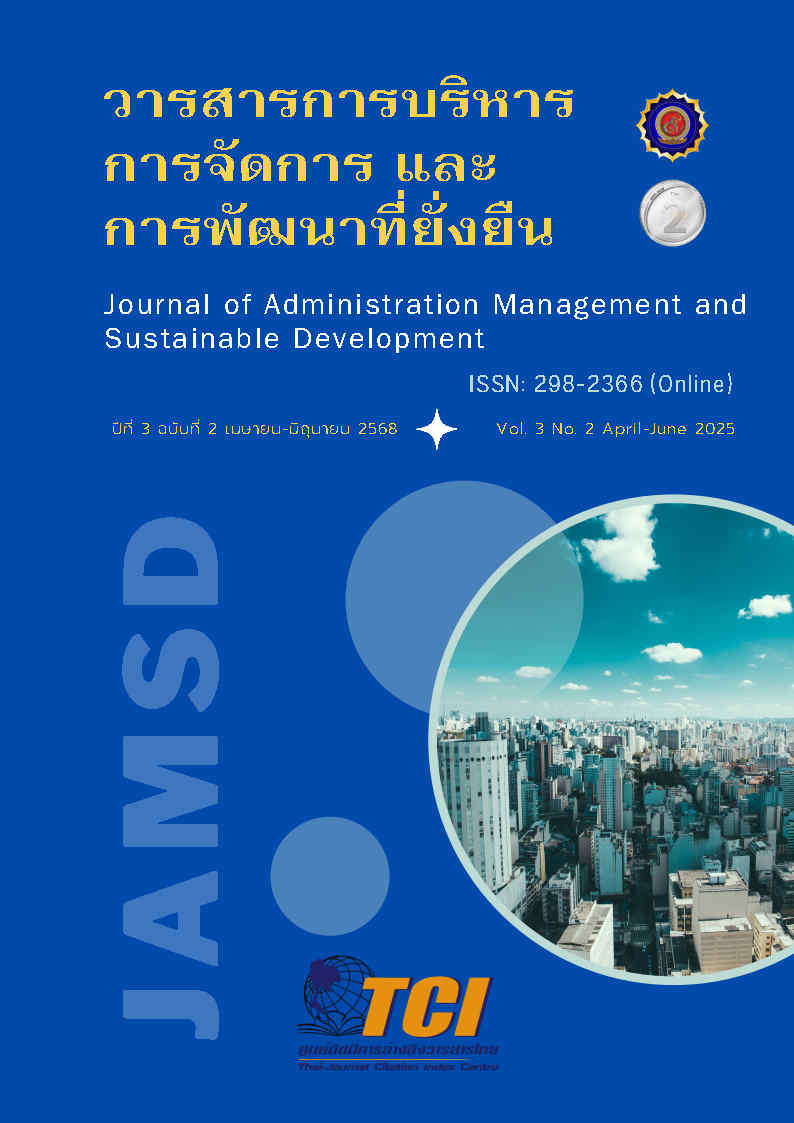Strategies management in high uncertainty: A case study of Poochay Kaihoy restaurant, Bangkokyai District, Bangkok
Keywords:
crisis, during high uncertainty, Poochay Kaihoy restaurantAbstract
This research aimed to 1. investigate the management strategies for crisis during high uncertainty at Poochaykaihoy Restaurant, Bangkokyai District, Bangkok, and 2. explore the development guidelines for management strategies for crisis during high uncertainty at the same restaurant. The sample consisted of 400 customers, 1 restaurant owner, and 5 employees. The research instruments were questionnaires and semi-structured interviews. Data were analyzed using mean, standard deviation, and content analysis. The findings revealed that 1. the overall management strategies crisis of high uncertainty were rated at a high level. When considering each aspect, all were rated highly, with the following order from highest to lowest mean: creating new innovations for the market, enhancing customer value, reducing costs and unnecessary functions, and eliminating unnecessary factors. 2. The development guidelines for crisis management strategies during high uncertainty indicated that the restaurant owner implemented strategic management to transform the business in the face of high market uncertainty. Such an outcome was achieved by utilizing the Blue Ocean Strategy, encompassing four key areas: Eliminate unnecessary factors by removing poorly performing menu items, simplifying complex processes, and discontinuing ineffective traditional advertising. In terms of reducing costs and non-essential functions, the business reduced the dining area, implemented a QR code system to minimize staffing needs, and utilized local ingredients to lower expenses. In terms of raising customer value, the business enhanced its packaging to a premium level, introduced unique menu items, and employed storytelling in online marketing. In terms of creating new innovations that had not yet existed in the market, the development of a subscription box model, a pre-order system, and live cooking show activities were carried out to offer customers a fresh and engaging experience.
References
Cochran, W. G. (1997). Sampling techniques (3rd ed.). John Wiley & Sons.
Elkington, J. (1997). Cannibals with forks: The triple bottom line of 21st-century business. Capstone.
Gössling, S., Scott, D., & Hall, C. M. (2021). Pandemics, tourism and global change: A rapid assessment of COVID-19. Journal of Sustainable Tourism, 29(1), 1-20.
Imai, M. (1986). Kaizen: The key to Japan’s competitive success. McGraw-Hill.
Kaplan, R. S., & Norton, D. P. (2008). The execution premium: Linking strategy to operations for competitive advantage. Harvard Business Press.
Kim, W. C., & Mauborgne, R. (2005). Blue ocean strategy: How to create uncontested market space and make the competition irrelevant. Harvard Business Review Press.
Kim, W. C., & Mauborgne, R. (2015). Blue ocean strategy: Expanded edition. Harvard Business Review Press.
Kotler, P., & Keller, K. L. (2016). Marketing management. Pearson
Mitroff, I. I. (2004). Crisis leadership: Planning for the unthinkable. Wiley.
Porter, M. E. (1985). Competitive advantage: Creating and sustaining superior performance. Free Press.
Rumsfeld, D. H. (2011). Known and unknown: A memoir. Sentinel.
Shah, B., & Khanzode, V. (2017). Storage allocation framework for designing lean buffers
in forward-reserve model: A test case. International Journal of Retail &Distribution Management, 45(1), 90-118. doi:10.1108/IJRDM-07-2016-0112.
Slack, N., Chambers, S., & Johnston, R. (2010). Operations management. Pearson Education.
Teece, D. J. (2010). Business models, business strategy and innovation. Long Range Planning, 43(2-3), 172-194.
World Health Organization. (2020). Impact of COVID-19 on food security and nutrition. Retrieved 24 April 2025 from https://www.who.int/news/item/13-10-2020-impact-of-covid-19-on-people's-livelihoods-their-health-and-our-food-systems.






